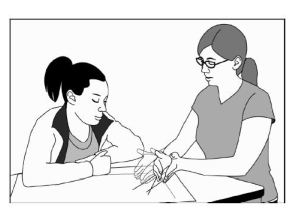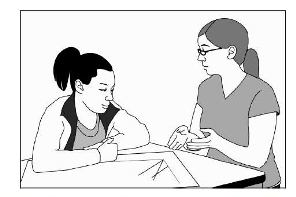Embodiment in Mathematics Teaching and Learning: Evidence from Teachers’ and Learners’ Gestures
February 8, 2013
A hunter boasts how she bagged a ten-point buck by pantomiming the dramatic events leading to the kill.
A mechanic explains the $1,000 worth of repair to your car using hand gestures to illustrate the work he did.
In each case the gestures intensify the communication by reproducing actions commonly performed—viewing through binoculars, raising a rifle, lifting a car hood, turning a key, listening to an engine crank to life.
When explaining ourselves we often gesture without even thinking about it. That’s because motor and perceptual simulations underlie our language and our imagery. We gesture to help communicate abstract ideas too. Just watch teachers and students in a math classroom. Professors Martha Alibali and Mitchell Nathan have.
They study how and why teachers and students use gestures to communicate mathematical concepts. From their perspective, mathematical knowledge doesn't just reside in the mind. It's embodied.
Why is it important to know that mathematical knowledge is embodied? Nathan and Alibali say it's essential for understanding and improving mathematics performance, instruction, assessment, and learning. Appreciating the embodied nature of mathematical thinking can help teachers (and researchers) understand why students find certain mathematics problems more difficult than others, identify suitable assessments to measure students' mathematical knowledge, design more effective learning environments, select appropriate ways to teach mathematics content, and understand why some instructional methods work better than others.
Gestures both facilitate speakers' language production and promote listeners' comprehension. Alibali and Nathan focus on the gestures that mathematics teachers and learners produce in explanations. That includes teachers' instructional explanations and learners' explanations of their thinking. Explanations provide a rich source of gesture data as students and teachers discuss equations, algebraic and geometric concepts, and word problems.
Alibali and Nathan argue that we use pointing gestures when thinking is grounded in the physical environment, representational gestures to communicate mental simulations of action and perception, and metaphoric gestures to communicate body-based concepts.

Representational Gesture
Pointing gestures indicate that the environment is an integral part of the cognitive system.
Mathematics teachers and learners use pointing gestures to link abstract mathematical ideas to the physical world, highlight corresponding aspects of related representations, and index the referents of their speech in talk about mathematical ideas.
Representational gestures show the motoric and perceptual simulations that underlie language and imagery. These gestures manifest mental simulations of action and perception, facilitate thinking or speaking by activating mental images, help speakers package ideas into units suitable for speaking, and contribute to listener comprehension.
Evidence suggests that explaining mathematical thinking involves simulating performing actions on mathematical objects, visual images of mathematical ideas (often mental images of inscriptions), and real-world situations that mathematical problems address. Speakers produce gestures to facilitate thinking about mathematical ideas or to promote effective communication about such ideas.

Metaphoric Gesture
Metaphoric gestures are a subclass of representational gestures. Some metaphoric gestures reflect concepts that are grounded in the body. These gestures suggest that thinking is based in the body. They also demonstrate that bodily resources enable "offline" thinking about objects, events, and relations not immediately present.
Metaphoric gestures often involve action and space. For example, two metaphors are "numbers are locations in space" (e.g., approaching zero) and "arithmetic is collecting objects" (e.g., put two and two together). Metaphors that involve space and action are readily expressed in gestures that reflect the spatial structure of the underlying images.
Implications for Research in the Learning Sciences
The “embodied thinking” perspective aligns with two themes central to contemporary research in the learning sciences. The first is the attempt to bridge the divide between research and practice. The second is the importance of analyzing teaching and learning in authentic settings.
The embodied perspective acknowledges the complexities of learning and teaching in real-world settings. It provides a framework for analyzing the action and communication that take place in such settings in an effort to better understand processes of knowledge change.
More about Alibali’s work: http://glial.psych.wisc.edu/index.php/psychsplashfacstaff/90
More about Nathan’s work: http://website.education.wisc.edu/~mnathan/Home.html


